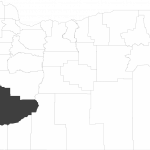Economic struggles. Decreasing public safety services. Failing infrastructure. Aging medical buildings. These issues plague many rural communities, but they are especially difficult on the southern coast of Oregon. For the past year, in Coos,  Curry, and western Douglas counties, the Community Service Center (CSC) has worked with the communities of this region to address these issues and more. The projects featured here span the entire range of the four CSC programs, including individual student research projects, focusing the energy and expertise of the University of Oregon on the state’s south coast. Without the assistance of the CSC, and the engagement of CSC students, interns, and AmeriCorps members, these communities would not be able to pursue these projects.
Curry, and western Douglas counties, the Community Service Center (CSC) has worked with the communities of this region to address these issues and more. The projects featured here span the entire range of the four CSC programs, including individual student research projects, focusing the energy and expertise of the University of Oregon on the state’s south coast. Without the assistance of the CSC, and the engagement of CSC students, interns, and AmeriCorps members, these communities would not be able to pursue these projects.
OPDR-Oregon Partnership for Disaster Resilience
The OPDR is tackling issues of disaster resilience from two different angles in the three-county area. It is helping each county update its Natural Hazards Mitigation Plan. These plans are required by FEMA to address hazard projects and to attract certain pools of funding for disaster mitigation and recovery. In a more cutting-edge project, OPDR is partnering with the Ford Family Foundation, an organization committed to rural vitality in Oregon, and the National Oceanic and Atmospheric Administration, to develop systems and networks that empower citizens to improve the resilience of their own communities.
EDAUC-Economic Development Administration University Center
The EDAUC is wrapping up a project in Coos County with the Oregon Wave Energy Trust that approaches economic development from an exciting new perspective. The Coos County coast has been identified as having promising qualities for the development of wave energy in terms of ocean conditions and topography. The EDAUC tailored a model called the community readiness assessment to explore the capacity of the community to support this type of industry. Research areas included infrastructure, public and private organizations, civic structures, and other metrics. The results of this study provide insights that can be used to lay a solid foundation if the community decides it wants to pursue ocean energy as an industry.
RARE-Resource Assistance to Rural Environments
In 2013–14, RARE AmeriCorps placed five members in the south coast region. Each addressed community-identified projects to improve the economy and environment of the region. Through RARE’s partnership with Oregon Food Bank, two members—one placed with South Coast Development Council and one placed with Curry Watersheds— addressed local food systems, looking at both food security and the local food economy. These placements were also in partnership with the Wild Rivers Coast Alliance. Two other placements, one in Coos Bay and one in Port Orford, worked toward improving the local economy, specifically through the Oregon Main Street Program. In the fifth placement, the member addressed a variety of issues in the City of Myrtle Point.
CPW-Community Planning Workshop
CPW is in the beginning stages of an assessment of historic theaters in Oregon, including three along the south coast. The CPW team will assess needs and coordinate marketing for the Savoy Theater in Port Orford, the Egyptian Theater in Coos Bay, and the Liberty Theater in North Bend, among others. Strategies may include preservation or renovation, as well as integration into cultural tourism outreach. These theaters have the potential to serve their communities as tourist destinations, downtown attractions, and historic landmarks.
These projects give a sense of the tremendous variety of ways that the CSC supports communities in Oregon, and particularly the communities of the south coast. Whether in preparation for hazards, support of local economic development and planning, or providing other needed services, the CSC is helping communities meet their goals while training the next generation of public servants.
